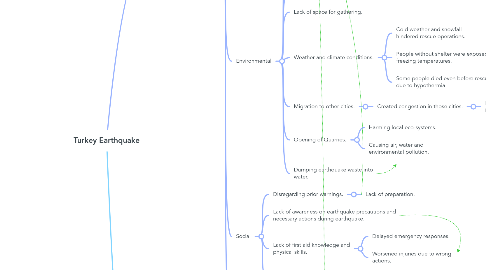
1. Material Dimensions
1.1. Economic
1.1.1. Preferring profit over safety.
1.1.1.1. The use of cheap labor leads to the employment of workers who are not specialized in the field.
1.1.1.2. Using low-quality materials to reduce costs.
1.1.1.3. Landowner prioritizing their profit by constructing high-rise buildings, disregarding that the area is in the earthquake danger zone.
1.1.1.4. Misusage of earthquake funds and taxes.
1.1.2. Destruction of workplaces.
1.1.2.1. Left people without any income.
1.1.2.1.1. Preventing people from meeting basic needs.
1.1.3. Increasing housing prices due to migration.
1.2. Functional
1.2.1. The intensity of the earthquake.
1.2.2. Unsuitable building types.
1.2.2.1. High risk of collapse.
1.2.3. Narrow street structure.
1.2.3.1. By creating congestion, makes it harder for people to escape quickly.
1.2.3.2. Increasing risk of being trapped under collapsed buildings due to the limited space.
1.2.4. Lack of open areas.
1.2.4.1. Limitation of safe assembly points prevents emergence responses and evacuation.
1.2.5. Uncontrolled burial procedures.
1.2.5.1. Issues on identifying the deceased.
1.2.5.1.1. People lose track of their loved-ones.
1.2.5.1.2. Lead to child abduction cases.
1.2.6. Delayed burials.
1.2.6.1. Bodies are left on the streets.
1.2.7. Collapse of infrastructure.
1.2.7.1. Collapse of water and sewage infrastructure.
1.2.7.1.1. Hygiene problems.
1.2.7.2. The disruption of electricity infrastructure.
1.2.7.2.1. Security, safety issues due to inoperative alarm systems and lack of lighting.
1.2.7.3. The disruption of communication infrastructure.
1.2.7.3.1. Issues on reaching to other people and contacting necessary services.
1.2.7.4. The disruption of roads.
1.2.7.4.1. Hindered access to the area.
1.3. Environmental
1.3.1. Fault line location.
1.3.2. Collapse of transportation infrastructure.
1.3.2.1. Hampers evacuation actions.
1.3.3. Chain reaction of disasters.
1.3.3.1. Earthquake triggered other disasters like tsunami and fires.
1.3.4. Lack of space for gathering.
1.3.5. Weather and climate conditions.
1.3.5.1. Cold weather and snowfall hindered rescue operations.
1.3.5.2. People without shelter were exposed to freezing temperatures.
1.3.5.3. Some people died even before rescued, due to hypothermia.
1.3.6. Migration to other cities.
1.3.6.1. Created congestion in those cities.
1.3.6.1.1. Housing shortage due to increasing demand of migrants.
1.3.7. Opening of Quarries.
1.3.7.1. Harming local eco-systems.
1.3.7.2. Causing air, water and environmental pollution.
1.3.8. Dumping earthquake waste into water.
1.4. Social
1.4.1. Disregarding prior warnings.
1.4.1.1. Lack of preparation.
1.4.2. Lack of awareness on earthquake precautions and necessary actions during earthquake.
1.4.3. Lack of first aid knowledge and physical skills.
1.4.3.1. Delayed emergency responses.
1.4.3.2. Worsened injuries due to wrong actions.
1.4.4. Lack of sense of solidarity.
1.4.4.1. Looting of aid.
1.5. Psychological
1.5.1. Earthquake survivors experienced severe psychological situations.
1.5.1.1. Post-traumatic stress disorder
1.5.1.1.1. Struggles in reintegrating into everyday life.
1.5.2. Loss of family members and loved-ones
1.5.2.1. Depression
1.5.2.1.1. Some people couldn't overcome this pain took their own lives.
1.5.3. Delayed psychological support.
1.5.3.1. People's mental health issues worsened due to the delay.
1.5.4. Survivors being constantly alerted
1.5.4.1. Sleep disturbances and insomnia.
2. Idealistic Dimensions
2.1. Ethical
2.1.1. Preferring profit over safety.
2.1.1.1. Allowing unsafe conditions, buildings in earthquake-prone areas.
2.1.1.2. Hiring unskilled labor to reduce costs.
2.1.1.2.1. Putting human lives at risk.
2.1.2. Misuse of earthquake taxes and funds.
2.1.3. Exploitation for personal gain.
2.1.3.1. Increasing the prices of basic goods to take advantage from victims.
2.1.4. Misrepresenting the volunteer donations as government-provided aid.
2.1.4.1. Public distrust.
2.1.5. Essential supplies like tents being sold instead of being donated.
2.1.6. Lack of empathy.
2.1.6.1. People sent unnecessary donations such as high heels,instead of sending needed supplies.
2.1.7. Failure to control land suitability and to conduct land assessments.
2.1.7.1. Constructing buildings on the danger zone.
2.1.7.2. Lack of legal action against ignored safety standards.
2.1.7.2.1. Lack of punishment encourages further actions.
2.2. Political
2.2.1. Lack of government preparedness.
2.2.2. Lack of crisis management skills.
2.2.2.1. Losing public trust in government.
2.2.3. Bureaucratic influences and political conflicts.
2.2.3.1. Delayed aid despite available resources.
2.2.3.2. Prioritizing certain groups in distributing aid.
2.2.4. Misuse of earthquake taxes and funds due to mismanagement.
2.2.4.1. Preventing proper help for the victims.
2.2.5. Military services were sent late because of political reasons.
2.3. Cultural
2.3.1. Having cultural biases.
2.3.2. Destruction of the archaeology museum.
2.3.2.1. Significant cultural and historical damage, destroying valuable heritage.
